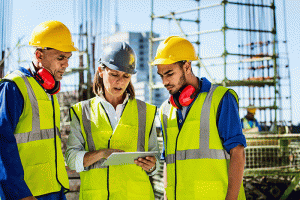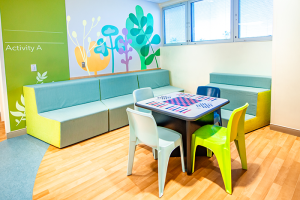Emerging technologies for health care building
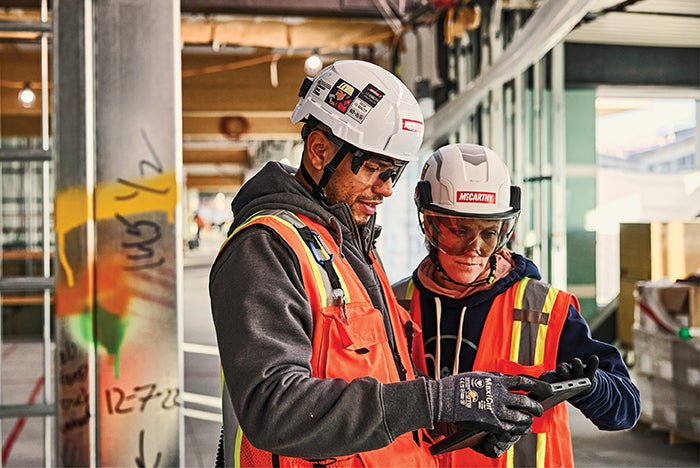
Field staff using utility mapping to validate the layout of penetrations in a concrete deck.
Image courtesy of McCarthy Holdings Inc.
The health care construction field has a unique opportunity to stand at the forefront of technological innovation, utilizing cutting-edge programs and devices to improve upon current practices and redefine the standards of building.
Health care projects provide a particularly interesting venue for experimentation in the construction field, given their diverse use cases, layouts, organizations and partners. From virtual visualization and robotics to advanced prefabrication and site logistics, health care design professionals are navigating a dynamic landscape of competitive technological advancements.
These advancements are met with a challenge to create an environment that brings health care organizations and their partners into the conversation from Day 1, increasing collaboration and developing a holistic, multifaced experience.
Seven trends
To operate at the highest level and produce efficient, safe and sustainable projects, health care building professionals need to stay informed of current and upcoming trends. Seven key trends emerging in the architecture, engineering and construction (AEC) field that health facilities professionals should consider implementing are discussed below:
1. Enhanced visualizations. Health care design professionals are adapting customer experience processes to include feedback directly from health care providers. With this added information, teams that specialize in creating enhanced visualizations are now able to leverage multiple technologies to communicate precisely how health care projects will come to life. By using highly detailed rendering techniques, 3D-printed physical models, 4D animations and immersive technologies such as virtual reality (VR) or augmented reality (AR), project teams can leverage visual storytelling to create clarity and confidence throughout the building process.
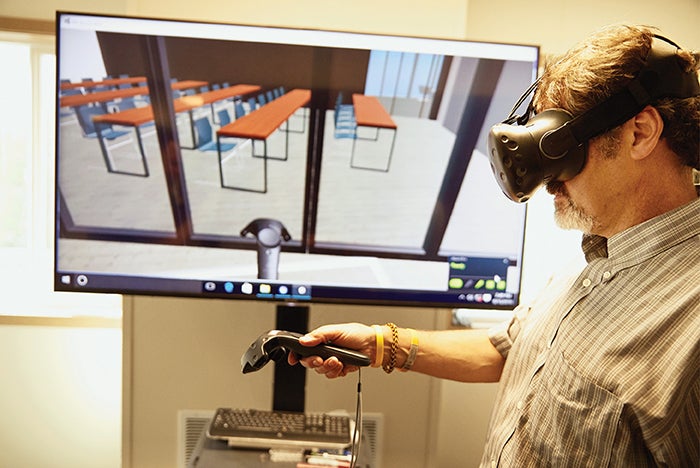
A virtual visualization mock-up allows health care providers to explore spaces first-hand.
Image courtesy of McCarthy Holdings Inc.
With the increased demand for enhanced visualization, one of the latest trend requests is the use of VR mock-ups for on-site building. In the early stages of a health care project, designers can offer health care professionals the opportunity to utilize the technology firsthand, solving the frequent issue of nuanced 2D design detail being misunderstood by individuals who operate within the space.
For example, doctors can use the VR tool to walk through a 3D model and experience what the operating room will feel like. They can then offer feedback to the design team, which can modify the space to the doctor’s expert specifications — sometimes with instantaneous results.
Enhancing the end-user experience, health care design professionals utilize advanced screening technology to make changes on the project front end, ensuring a functional layout for the professionals who will be utilizing the space. By bringing the customer into the experience and the exact room in which they will be operating, builders can use virtual visualization mock-ups to get the job done right the first time.
2. Utility mapping. AR systems illustrate the location and alignment of existing utilities by using AR programs that are accessible on an iPad. Current AR systems are not only easier for novices to learn and utilize but are also more efficient and can assist in preventing challenges down the road. Benefits include support of larger data sets, demonstrating potential utility conflicts and facilitation of project team collaboration. Integrating AR mapping programs reduces human error and speeds up situational awareness of the surrounding infrastructure. It also provides additional quality assurance that previous systems could not.

An iPad screen capture of site mapping technology using augmented reality.
Image courtesy of McCarthy Holdings Inc.
Efficient utility mapping serves as a supplemental risk management strategy, which is especially beneficial to health care projects. AR programs can help teams be more accurate and reduce unknowns during construction. Taking into consideration the nature of health care facilities, the comprehensiveness of AR mapping is a vital draw for partners and clients to help ensure utilities, such as pre-existing oxygen and medical gas lines, are not disturbed during construction.
Utility mapping has historically been executed by outside parties as a means of outsourcing large amounts of front-end project work, but that is changing. Self-performed utility mapping service is one of the next steps in developing comprehensive servicing capabilities for builders. Combined with AR systems, utility mapping is quickly becoming an opportunity for increased efficiency, risk management and competitive technological servicing for hospitals and partners.
3. Robotics and drones. Robotic assistance is an exciting opportunity to optimize labor and increase productivity on myriad fronts. Recent developments in robotic technology have demonstrated that the future of health care construction is tied to efficient use of layout, on-site and drone robots.
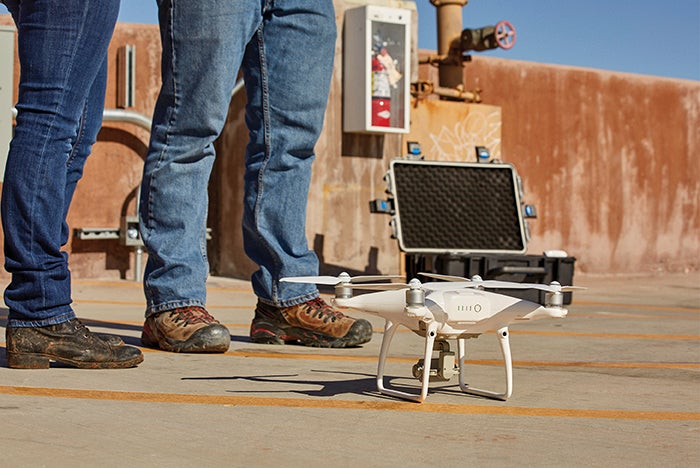
Drones can be used to survey exterior buildings and report potential damage.
Image courtesy of McCarthy Holdings Inc.
Two layout robots that have reached the end of their prototype phases and are being broadly adopted in the field are Dusty Robotics, Mountain View, Calif., and Rugged Robotics, Houston. Dusty Robotics, which resembles a Roomba-style robot, is used on job sites to print floor-plan layouts on concrete using coordinated drawing data. Rugged Robotics acts similarly but utilizes localized GPS technology to lay out fully coordinated architecture and engineering designs directly onto unfinished floors. With the use of these layout robots, communication and collaboration are increased among project partners because they’re building from the same data on an accelerated schedule.
On-site robots are currently being used in solar fields to perform quality inspections and fire prevention, running missions and mitigating risk. Within these robots are integrated still cameras that leverage artificial intelligence (AI) and computer vision to verify productivity within a specified time. This technology has potential for future application across many areas, with requirements for rooftop solar units being mandated in some geographies.
The integration of drones with thermal imaging technology for exterior quality-control checks provides increased job-site safety and efficiency by mitigating the risk of human error. These drones provide a more accurate and comprehensive assessment of health care facility exteriors by identifying pockets of energy loss, such as heat escaping the building or water pooling on top of the roof. These energy pockets can be indicative of insulation gaps or structural issues invisible to the eye. Drones are also used to navigate rooftops and scaffolding, mitigating unnecessary risks to on-site workers and saving hours of manual labor.
4. Tech-enabled craft workers. Craft workers are a crucial piece of the construction puzzle, executing specialized skills to bring facilities to life. It’s no longer enough to provide basic equipment and expect outstanding results; builders must invest in their craft workers and their “tools” as the field becomes more technologically savvy.
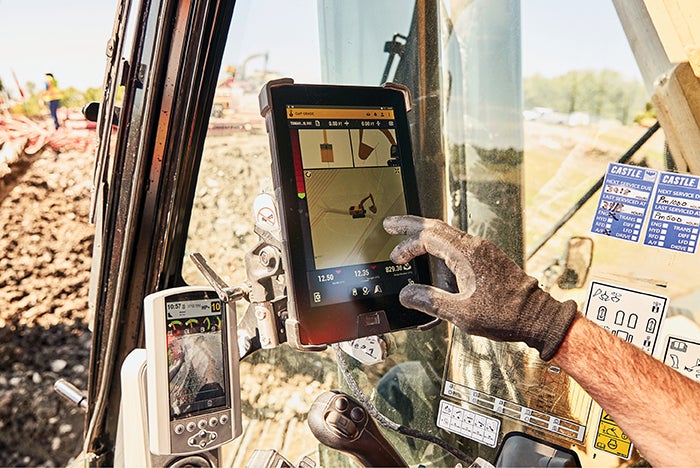
A craft worker using a tablet to improve job-site contractor accuracy.
Image courtesy of McCarthy Holdings Inc.
In the area of craft professional leadership, the ability to gauge a team’s performance, discover new efficiencies and access drawings and models can be enhanced with technology. Lacking proficiency in technology places limitations on craft workers, restricting their capacity to embrace technological advancements and engage in innovative endeavors.
It’s important to ensure craft workers are equipped with the latest technology to encourage cross-team collaboration. Across each job, that could mean an appropriate laptop, tablet or smartphone provided to foremen.
Some benefits of tech-enabled craft workers include enhanced efficiency with the utilization of construction management software and project scheduling applications. Craft workers need not rely on traditional paper-based methods; by taking on the additional expense of purchasing and providing technology, employers can become more appealing to prospective craft employees and increase their return on investment over time.
5. AI technologies. Perhaps the most controversial trend making waves in AEC communities is AI, one of the biggest opportunities for organizational development in construction technology. This can include anything from generative design to predictive analytics to natural language processing (NLP).
The concern with adaptation of AI as a “brain” for an organization comes into play when tasks are delegated to a system that lacks the human element. Behind the scenes, construction professionals have been discussing implementation of these emerging technologies.
The field is currently divided. Some construction companies are executing a full block of AI usage internally, and others are finding ways to utilize AI that might work well in the short term but can be perceived as disingenuous when viewed holistically. One thing is certain: AI isn’t going away. There are multiple pilot projects in place to utilize NLPs as a document management system, allowing for easier retrieval of key data and documents along with heightened intuitive administrative organization.
There is also an opportunity to produce internal machine learning programs, populate them with project data and use them to facilitate the production of prefabrication projects.
6. Prefabrication 2.0. Prefabrication has quickly become the standard, but there is much more to be discovered. The future of prefab, or “prefab 2.0,” will be in the development of communication and collaboration platforms between designers, owners and builders. These service platforms will take potential prefabrication manufacturers for all products that are available to the construction industry and empower design and construction experts with the tools to identify the right prefabrication strategy for a specific use case.
To keep up with the evolving needs of clients and partners, health care facility designers should consider an approach to prefab 2.0 that uses AI to capture the power of a nationwide supply chain in a way that’s repeatable, easy to comprehend and inclusive of field construction expertise. In turn, this will assist owners in making prefabrication and modular decisions very early in their projects, saving time and money.
7. Digital site logistics tools. In days past, static documents were the standard for connecting construction teams and communicating site logistics needs. As these tools continue to progress, digitizing site logistics will create seamless adjustments of delivery schedules to allow for changes and updates.
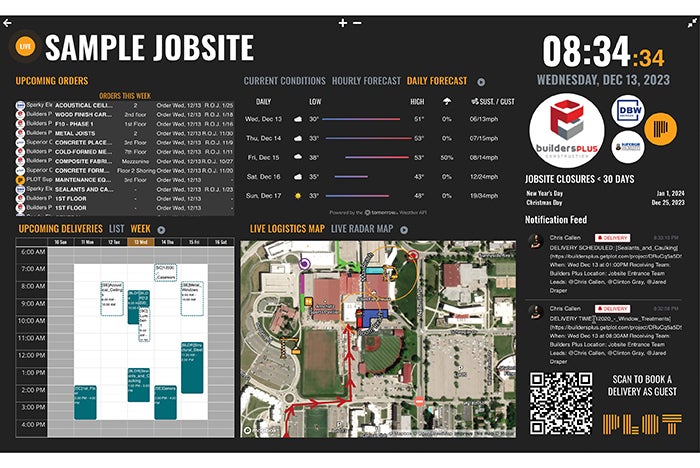
Digital site logistics tools can connect construction teams and communicate site logistics needs.
Image courtesy of McCarthy Holdings Inc.
There are multiple digital site logistics applications being piloted by health care construction professionals. These are particularly beneficial to navigate complex campuses, road closures and delivery reroutes, or issue equipment without having to reprint and mark up documents unnecessarily. These tools aim to make on-site project deliveries as easy as ordering an Uber ride.
Health care building professionals engaged in the pilot testing of these applications are seeing significant value added to their organizations. Programs such as digital job-site logistics applications allow professionals to concentrate on their core responsibilities rather than administrative tasks such as rescheduling.
Digitalization of job-site logistics is not only a key emerging trend but will become the standard, with opportunities for expansion as they become implemented. The early adoption of these pilot programs will lead to better service delivery for clients and partners down the road.
Continually evolving
Construction technology is continually evolving at a rapid pace.
By keeping up on the latest trends and prioritizing collaboration, health care construction professionals are better able to integrate appropriate technologies.
Embracing a spirit of innovation while providing high levels of service will set these facilities projects apart.
Enrico Bertucci, PE, is vice president of innovation and McKenzie Lewis, Assoc. DBIA, is manager of emerging technology at McCarthy Holdings Inc., St. Louis. They can be reached at ebertucci@mccarthy.com and mlewis@mccarthy.com.

